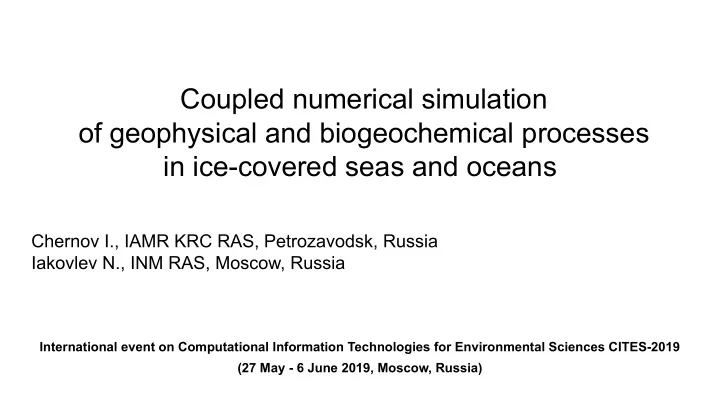

Coupled numerical simulation of geophysical and biogeochemical processes in ice-covered seas and oceans Chernov I., IAMR KRC RAS, Petrozavodsk, Russia Iakovlev N., INM RAS, Moscow, Russia International event on Computational Information Technologies for Environmental Sciences CITES-2019 (27 May - 6 June 2019, Moscow, Russia)
Modeling the biogeochemistry What are the distribution of chemical elements in the ocean, how they change and why. Typical questions are ● What are the mean concentrations and why are they such ● How are they distributed in space ● How do they change in time Substances of interest are those influenced by biological processes. First of all, this is carbon. Also nitrogen, phosphorus, silicon, oxygen etc.
BFM: a pelagic ecosystem model ● Biogeochemical Flux Model developed by the consortium: ○ Centro Euro-Mediterraneo sui Cambiamenti Climatici ( CMCC ) ○ Dipartimento di Fisica e Astronomia, Alma Mater Studiorum Università di Bologna ( UNIBO DIFA ) ○ Istituto Nazionale di Oceanografia e di Geofisica Sperimentale ( OGS ) ○ Department of Oceanography, University of Cape Town ( UCT ) ○ Finnish Environment Institute ( SYKE ) ● Used for various scales and climatic regions: ○ Adriatics, Mediterranian; ○ Atlantic Ocean, Global Ocean; ○ Included into NEMO, MITgcm, POM ○ Used in the projects: MyOcean, GREENSEAS, GEOCARBON, MEECE etc. ● Contains the sympagic component ● Contains several benthic models ○ Though we use a simple exchange description
Biogeochemical model ✓ Multielement description (C, P, N, Si, Chl a ) ✓ Trophic net The classical and the microbial loop ✓ 4 groups of phytoplankton ✓ 4 gropups of zooplankton ✓ Vichi et al., 2013 The page prepared by Paolo Lazzari, OGS, Trieste, Italy
Benthic exchange ● some components sink wrt water: ○ detritus (5 m/day) ○ phytoplankton (variable speed) ● Purely pelagic model also works (matter in the bottom layer) ● Sinking matter is accumulated “on the bottom” ● 25% slowly remineralized matter (C,N,P), 75% is quick. ● Rate is proportional to the amount ● And exponentially on the temperature ● Inorganic return is used by the diffusion.
Model can be tuned ● Stoichiometric concentrations for some groups: N=N(C), P=P(C) ● Join, split, exclude, or add groups. ● Turn a cycle on/off ● Diagnostic variables are functions of the phaze vector: numerous! ● Submodels of sea ice and benthic ecosystems
Interaction of GOCMs and BFM ● Process splitting ● Advection, rivers, flux from atmosphere, diffusion, sinking all come from GOCM ● Time derivative of the phaze vector and diagnostics for each node provided by BFM ● Environment parameters GOCM -> BFM (T, S, 𝞻 , light, wind, CO2, ...) ● Amount of plankton may be used for sea optics (feedback!) ● Advection is the most costly!
General ocean circulation models INMCM - The Earth system model of INM RAS, the ocean component. ● sigma-variable ● Sinking is separate. No benthos: just bury the matter. ● Rivers, precipitation provided by other components. JASMINE - The White Sea model based on the FEMAO for the Arctic Ocean ● z-coordinate ● Several ice thickness levels ● Exchange with the bottom (the Sea is pretty shallow!)
What can be calculated? ● Daily average chlorophyll for the sea or a bay ● Biomass of plankton or its group ● Primary production, net or gross, for each group. ● Redfield ration, limiting factor ● Spatial and temporal variability ● Inner variability of the system ● Numerical experiments
First results: chlorophyll Jan May Oct Aug
First results: chlorophyll https://www.liverpool.ac.uk/climate/research/newbiogeo/ https://dabrownstein.com/category/plankton-maps/
First results: phosphates World Ocean Atlas
The White Sea • Size ~500 км, • Mean/max depth: 67/340m, • Strong tidal motion • Strong river discharge • Ice-free in summer
The White Sea, chlorophyll, 10.05.2006 - 19.07.2006
The White Sea, chlorophyll, 10.05.2006 - 19.07.2006 , 24.07-04.10.2006
Chlorophyll distribution in May, multi-year average http://optics.ocean.ru Model, May 13 Total chlorophyll in May, mg/m3
Area-mean chlorophyll Onega bay Dvina bay The White Sea Middle part Kandalaksha bay
Influence of light and bottom Kandalaksha bay Mezen bay Onega bay Middle part Voronka Dvina bay
Sympagic ecology ● Letizia Tedesco, SYKE (Helsinki) ● Ice contains brine-filled pores with plankton ● Phytoplankton is surviving and ice-specific; zooplankton; bacteria; matter. ● Single 2D bioactive layer ● Light, Т, S, ice thickness, and its speed taken from the GOCM ● Pelagic values from the BFM ● Advection by the GOCM ● Ice growth -> capturing stuff from water ● Melting -> release of matter and/or organizms to water, the flux used by diffusion
Thank You for Your attention!
Recommend
More recommend